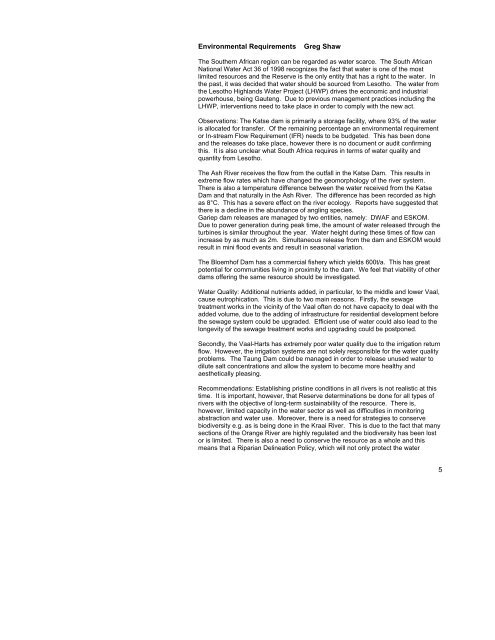An integrated assessment of socio-economic and ... - Unesco
An integrated assessment of socio-economic and ... - Unesco
An integrated assessment of socio-economic and ... - Unesco
You also want an ePaper? Increase the reach of your titles
YUMPU automatically turns print PDFs into web optimized ePapers that Google loves.
Environmental Requirements Greg Shaw<br />
The Southern African region can be regarded as water scarce. The South African<br />
National Water Act 36 <strong>of</strong> 1998 recognizes the fact that water is one <strong>of</strong> the most<br />
limited resources <strong>and</strong> the Reserve is the only entity that has a right to the water. In<br />
the past, it was decided that water should be sourced from Lesotho. The water from<br />
the Lesotho Highl<strong>and</strong>s Water Project (LHWP) drives the <strong>economic</strong> <strong>and</strong> industrial<br />
powerhouse, being Gauteng. Due to previous management practices including the<br />
LHWP, interventions need to take place in order to comply with the new act.<br />
Observations: The Katse dam is primarily a storage facility, where 93% <strong>of</strong> the water<br />
is allocated for transfer. Of the remaining percentage an environmental requirement<br />
or In-stream Flow Requirement (IFR) needs to be budgeted. This has been done<br />
<strong>and</strong> the releases do take place, however there is no document or audit confirming<br />
this. It is also unclear what South Africa requires in terms <strong>of</strong> water quality <strong>and</strong><br />
quantity from Lesotho.<br />
The Ash River receives the flow from the outfall in the Katse Dam. This results in<br />
extreme flow rates which have changed the geomorphology <strong>of</strong> the river system.<br />
There is also a temperature difference between the water received from the Katse<br />
Dam <strong>and</strong> that naturally in the Ash River. The difference has been recorded as high<br />
as 8°C. This has a severe effect on the river ecology. Reports have suggested that<br />
there is a decline in the abundance <strong>of</strong> angling species.<br />
Gariep dam releases are managed by two entities, namely: DWAF <strong>and</strong> ESKOM.<br />
Due to power generation during peak time, the amount <strong>of</strong> water released through the<br />
turbines is similar throughout the year. Water height during these times <strong>of</strong> flow can<br />
increase by as much as 2m. Simultaneous release from the dam <strong>and</strong> ESKOM would<br />
result in mini flood events <strong>and</strong> result in seasonal variation.<br />
The Bloemh<strong>of</strong> Dam has a commercial fishery which yields 600t/a. This has great<br />
potential for communities living in proximity to the dam. We feel that viability <strong>of</strong> other<br />
dams <strong>of</strong>fering the same resource should be investigated.<br />
Water Quality: Additional nutrients added, in particular, to the middle <strong>and</strong> lower Vaal,<br />
cause eutrophication. This is due to two main reasons. Firstly, the sewage<br />
treatment works in the vicinity <strong>of</strong> the Vaal <strong>of</strong>ten do not have capacity to deal with the<br />
added volume, due to the adding <strong>of</strong> infrastructure for residential development before<br />
the sewage system could be upgraded. Efficient use <strong>of</strong> water could also lead to the<br />
longevity <strong>of</strong> the sewage treatment works <strong>and</strong> upgrading could be postponed.<br />
Secondly, the Vaal-Harts has extremely poor water quality due to the irrigation return<br />
flow. However, the irrigation systems are not solely responsible for the water quality<br />
problems. The Taung Dam could be managed in order to release unused water to<br />
dilute salt concentrations <strong>and</strong> allow the system to become more healthy <strong>and</strong><br />
aesthetically pleasing.<br />
Recommendations: Establishing pristine conditions in all rivers is not realistic at this<br />
time. It is important, however, that Reserve determinations be done for all types <strong>of</strong><br />
rivers with the objective <strong>of</strong> long-term sustainability <strong>of</strong> the resource. There is,<br />
however, limited capacity in the water sector as well as difficulties in monitoring<br />
abstraction <strong>and</strong> water use. Moreover, there is a need for strategies to conserve<br />
biodiversity e.g. as is being done in the Kraai River. This is due to the fact that many<br />
sections <strong>of</strong> the Orange River are highly regulated <strong>and</strong> the biodiversity has been lost<br />
or is limited. There is also a need to conserve the resource as a whole <strong>and</strong> this<br />
means that a Riparian Delineation Policy, which will not only protect the water<br />
5
















